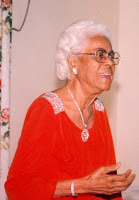Marjorie Prentice Saunders (1913-2009)

Name: Marjorie Prentice Saunders
Birth: February 25, 1913
Death: March 2, 2009
Industry: Theology; Education
In 2005, she published her autobiography, Born to Serve: The Pioneering Ministries Marjorie Sanders, a publication which is indicative of her contribution to the religious and education landscape of Jamaica. Born in 1913, Marjorie Saunders (popularly called Madge Saunders) was raised in a middle class family in Galina, St. Mary, and was the sixth of seven children for her parents. Her mother, Ida Myers Saunders, died at a young age, and her father, Walter E. Saunders, was a wharf keeper and manager of Kerr and Company in Port Maria. She studied at Free Hill School in Port Maria, St. Mary, St. Colm’s Missionary College in Edinburgh, Bethlehem Moravian Training College in St. Elizabeth, and at London University where she attained a Certificate of Proficiency in Religious Knowledge.
Life’s Work
Saunders, from a young age, was actively involved in the religious and educational life of Jamaica. At the age of fourteen, following her success in the Pupil Teachers Examinations, she taught as a voluntary pupil teacher at Galina Primary School in St. Mary. Here she began to develop her understanding of education and decided to advance her knowledge in the field through Bethlehem Moravian Teachers’ College in St. Elizabeth. She successfully completed three years (1946-1948) at the College, where she was head girl for the entire period of her study. Not only was she the head girl for three years, she was the first to have had acquired such a position in the first year of study.
After graduating from teachers’ college, Saunders served as the principal of Hopeton Primary School, a Moravian Institution. As a result of her father’s illness, she had to retire from this post in order to care for him in Galina St. Mary. Here, she worked as a teacher at Galina Primary School, a post in which she previously served. While serving in this post, Saunders established arguably, the first school kitchen in Jamaica. This provided meals for students who came from deprived economic circumstances.
Saunders’s service at Galina Primary ended when she decided to become a committed servant of the Presbyterian Faith. She had always had an interest in religious work, but in 1965, an offer from the Presbyterian Church to be trained in Scotland for three years expedited her decision to become a Presbyterian worker. She accepted the offer and was trained at St. Colm’s Missionary College in Edinburgh, Scotland, where she successfully completed the training programme; she was the first native Jamaican female to have had such training.
While studying in Britain, Saunders used her time to do religious work. She was Associate Minister of St. James Presbyterian Church, Sheffield, England. In this post, she was able, it is believed, to have “served as a ‘bridge’ in a truly theological sense between the migrant and largely coloured community and white host community of Great Britain. One of the ways in which she did this was through the publication of a handbook, “Living in Britain”, for migrants in Britain. She was also:
- Founder and First President of the International Friendship Guild, St. James Presbyterian Church
- Member of the Sheffield Council of Churches and the Sheffield Radio Council
- Executive member of the Sheffield Committee for Community Relations
- Official School Visitor Sheffield Education Department
- Vice President of the West Indian Association Sheffield
- Member of the Migrant Standing Committee of the British Council of Churches
Education and religion were indispensable to her life. Following her return to Jamaica, in 1976, Saunders became not just the first female minister of religion, but later, an icon in the United Church of Jamaica and Grand Cayman, where she was assigned to the Salem branch in St. Mary. Although this was the first religious post in which Saunders served on her return from Britain, it was not the first time she was doing religious work in Jamaica. She had served as the first fulltime Youth Organizer of the Presbyterian Church of Jamaica, a member of the Synodical Council of the Presbyterian Church of Jamaica and the Executive Committee of the Assembly of the Reformed Church in the Caribbean.
In the field of education, Saunders continued to make a marked contribution. Out of concern about the lack of teacher training, particularly in early childhood education, she helped to establish formal training for early childhood teachers. One of the ways which she started this was to train six teachers, all from different parishes, for a period of six weeks. These teachers were the first trained basic school teachers Jamaica had. She was also instrumental in the creation of Mona and Iona Preparatory Schools, Meadowbrook High School, and the Kelly Lawson School, an institution for training teachers and youth workers (Peace Women Across the Globe, 2013).
Saunders died on the 2nd of March 2009, but her work never went unnoticed. Her accolades include:
- Nobel Peace Prize Nominee, 2005
- Certificate and Badge of Honour for meritorious service, 1960
References
- Atty, Dan Perky. “The Reverend Marjorie Prentice Saunders.” United Church of Jamaica and Grand Cayman Islands, March 1981.
- Guy, Henry A. & Lavern Bailey. Women of Distinction in Jamaica. Kingston: Golding Printing Service, 1978.
- Laing, Ellis. “Madge Saunders: ‘Born to Serve’.” Kingston: The Gleaner
- “Born to Serve: the Pioneering Ministries of Marjorie Prentice Saunders.” The Sunday Observer, 18 September, 2005.
- Neita, Clifton. Who’s Who Jamaica British West Indies 1954. Kingston: Who’s Who Jamaica Limited, 1954.
- “Marjorie Prentice has Passed Away.” Peace Women Across the Globe. 1000peacewomen.org
Related Documents
- Born to Serve: The pioneering ministry of Marjorie Prentice Saunders. Reviewed by AW Sangster. Sunday Observer, September 18, 2005, p. 20.
- Madge Saunders: ‘Born to serve’. By Ellis Laing. The Gleaner.
- To do Christian, social work among West Indians in Sheffield. The Daily Gleaner, September 3, 1965, p. 8.
- The Reverend Marjorie Prentice Saunders. March 1981.
